September 15, 2023 report
Using zooarchaeology and collagen mass-peptide fingerprinting to study whales before industrialization

Bob Yirka
news contributor

A team of archaeologists, biologists and historians from institutions in Norway, the Netherlands, the U.K. and France has found via use of zooarchaeology techniques and collagen mass-peptide fingerprinting that humans contributed to reductions in some whale populations before the advent of industrial whaling began in Europe. In their project, reported in the journal Royal Society Open Science, the group studied recovered ancient bones from whales that lived off the coast of Europe over the years 3,500 BCE to the 18th century CE.
Prior research has suggested that some whale populations off the coast of Medieval Europe may have suffered due to human activities, but to date, little research has been done to discover the extent. In this new effort, the researchers obtained access to 719 bones from that era and applied both traditional zooarchaeology techniques and collagen mass-peptide fingerprinting to determine which types of whales the bones came from.
By studying the bones, the research team was able to see that early humans were consuming whale meat from whales that no longer live off the coast of Europe. They found evidence of 334 right whales, which are seldom seen in the northeastern Atlantic, and 110 samples of gray whales, a species that no longer lives off the coast of Europe.
The research group notes that some of the samples may have come from beached whales or whales that died from other causes and washed up on shore, in addition to those that were hunted. They note that prior to the establishment of industrial whaling, humans preferred to go after both species because they were more docile than others in the region, and thus much easier to hunt.
The team suggests that early hunters may have been at least partly responsible for the population collapse of both species. They also suggest it's likely that later whale hunters using more advanced techniques as part of industrialized whaling operations were responsible for the complete collapse of the two species.
The research team concludes that learning more about whale population levels prior to human hunting could help in modern preservation efforts.
Written for you by our author —this article is the result of careful human work. We rely on readers like you to keep independent science journalism alive. If this reporting matters to you, please consider a (especially monthly). You'll get an ad-free account as a thank-you.
More information: Youri van den Hurk et al, The prelude to industrial whaling: identifying the targets of ancient European whaling using zooarchaeology and collagen mass-peptide fingerprinting, Royal Society Open Science (2023).
Journal information: Royal Society Open Science
© 2023 Science X Network

















